We start with a constant-sum game: for every possible outcome of the game,
the utility ![]() of Player 1 plus the utility
of Player 1 plus the utility ![]() of Player 2, adds
to a constant. For example, if two firms are competing for market shares,
then
of Player 2, adds
to a constant. For example, if two firms are competing for market shares,
then ![]() .
.

The possible outcomes are best represented in a table.
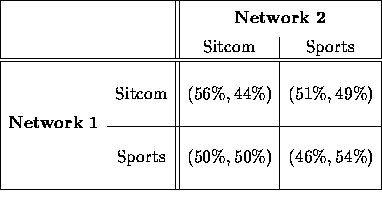
We can solve Battle of the Networks as follows: from Network 1's point of view, it is better to show a sitcom, whether Network 2 shows a sitcom or sports. The strategy ``Show a Sitcom'' is said to dominate the strategy ``Show Sports'' for Network 1. So Network 1 will show a sitcom. Similarly, Network 2 is better off showing sports whether Network 1 shows a sitcom or sports. In other words, Network 2 also has a dominating strategy. So Network 2 shows sports. The resulting outcome, namely 51% viewer share to Network 1 and 49% to Network 2, is an equilibrium, since neither of the two players in this game can unilaterally improve their outcome. If Network 1 were to switch from sitcom to sports, its viewer share would drop 5%, from 51% to 46%. If Network 2 were to switch from sports to sitcom, its viewer share would also drop, from 49% to 44%. Each network is getting the best viewer share it can, given the competition it is up against.
In a general 2-person game, Strategy i for Player 1
dominates Strategy k for Player 1 if ![]() for every j. Similarly, Strategy j for Player 2
dominates Strategy
for every j. Similarly, Strategy j for Player 2
dominates Strategy ![]() for Player 2 if
for Player 2 if ![]() for every i.
for every i.
In a general 2-person game, Strategy i for Player 1 and Strategy j
for Player 2 is an equilibrium if the corresponding outcome
![]() has the following property:
has the following property: ![]() is the largest
element
is the largest
element ![]() in column j and
in column j and ![]() is the largest element
is the largest element
![]() in row i. When such a pair i,j exists, a pure strategy
for each player provides an optimal solution to the game. When no such
a pair exists, the players must play mixed strategies to maximize their
gains (see Section 10.1.2).
in row i. When such a pair i,j exists, a pure strategy
for each player provides an optimal solution to the game. When no such
a pair exists, the players must play mixed strategies to maximize their
gains (see Section 10.1.2).
There is an easy way to relate constant-sum games and zero-sum games.
Let ![]() and
and ![]() be the payoffs of players 1 and 2, respectively,
in a constant-sum game:
be the payoffs of players 1 and 2, respectively,
in a constant-sum game: ![]() .
Now consider a new set of payoffs of the form
.
Now consider a new set of payoffs of the form
![]()
Clearly, ![]() , so we now have a zero-sum game. Using the relation
, so we now have a zero-sum game. Using the relation
![]() , we can rewrite the payoffs
, we can rewrite the payoffs ![]() and
and ![]() as:
as:
![]()
These are positive, linear transformations of utility, and so, according to the expected utility theorem (see 45-749), they have no effect on decisions. For the Battle of the Networks example, the new table becomes
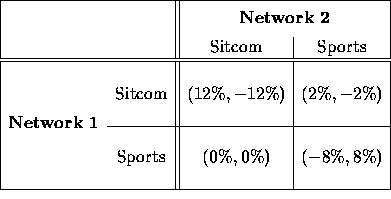
It represents each network's advantage in viewer share over the other network. Whether you reason in terms of total viewer shares or in terms of advantage in viewer shares, the solution is the same.
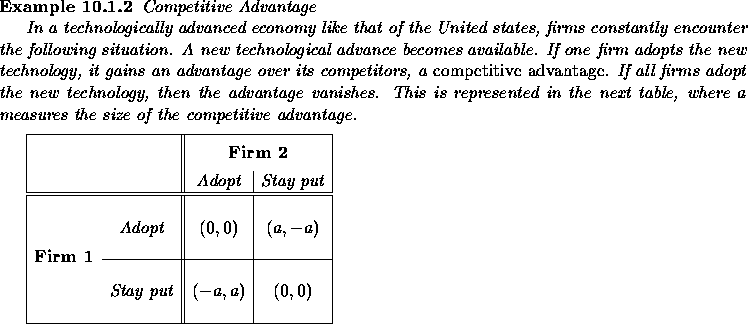
Each firm has two strategies, either Stay put, or Adopt the new technology. Firm 1 has an incentive to adopt the new technology: in the event Firm 2 stays put, then Firm 1 gets the competitive advantage a, and in the event Firm 2 adopts the new technology, then Firm 1 erases its competitive disadvantage -a. So, whatever Firm 2's decision is, Firm 1 is better off adopting the new technology. This is Firm 1's dominant strategy. Of course, the situation for Firm 2 is identical. So the equilibrium of Competitive Advantage is for both firms to adopt the new technology. As a result, both firms get a payoff of 0. This may seem like a paradox, since the payoffs would have been the same if both firms had stayed put. But, in Competitive Advantage, neither firm can afford to stay put. The firms in this game are driven to adopt any technology that comes along. Take, for example, the hospital industry. Magnetic Resonance Imaging (MRI) is a new technology that enhances conventional X rays. It allows doctors to see body damage in ways that were not previously possible. Once MRI became available, any hospital that installed an MRI unit gained a competitive advantage over other hospitals in the area. From a public policy standpoint, it may not make much sense for every hospital to have its own MRI unit. These units are expensive to buy and to operate. They can eat up millions of dollars. Often, one MRI unit could handle the traffic of several hospitals. But an individual hospital would be at a competitive disadvantage if it did not have its own MRI. As long as hospitals play Competitive Advantage, they are going to adopt every new technology that comes along.
The two-person games we have encountered so far have had unique pure strategy equilibria. However, a two-person zero-sum game may have multiple equilibria. For example, consider the game:
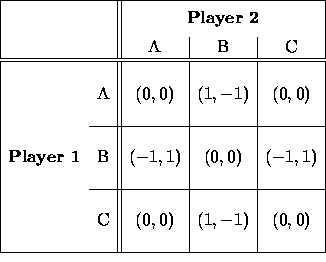
Each player can play indifferently strategy A or C and so there
are four pure strategy equilibria, corresponding to the four corners
of the above
table. Note that these equilibria all have the same payoff. This is
not a coincidence. It can be shown that this is always the case.
Every equilibrium of a 2-person zero-sum game has the same payoff.
For pure strategy equilibria, there is a simple proof:
Suppose two equilibria had payoffs
(a,-a) and (b,-b) where ![]() . If these two solutions lied
on the same row or column, we would get an immediate contradiction
to the definition of an equilibrium. Let (a,-a) lie in row i and
column k and let (b,-b) lie in row j and column
. If these two solutions lied
on the same row or column, we would get an immediate contradiction
to the definition of an equilibrium. Let (a,-a) lie in row i and
column k and let (b,-b) lie in row j and column ![]() .
The subtable corresponding to these two rows and columns looks as
follows
.
The subtable corresponding to these two rows and columns looks as
follows
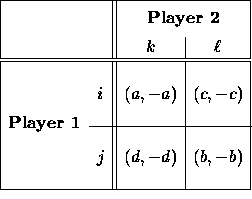
Since (a,-a) is an equilibrium, we must have ![]() (from
Player 1) and
(from
Player 1) and ![]() (from Player 2). Similarly, since (b,-b)
is an equilibrium, we must have
(from Player 2). Similarly, since (b,-b)
is an equilibrium, we must have ![]() and
and ![]() .
Putting these inequalities together, we get
.
Putting these inequalities together, we get
![]()
This implies that a = b, which completes the proof.

It is clear from this table that advertising on television is a
powerful marketing tool. If Company 1 switches from not advertising
to advertising on television, its profits go up 20%, everything else
being equal, when Company 2 does not advertise on TV, and they go up
35% when Company 2 advertises on TV; the same is true if the roles
are reversed. In other words, advertising on television is
a dominant strategy for each of the companies.
Hence the equilibrium is when both companies advertise on television, with
a payoff of $27 million. We say that an outcome ![]() is efficient if there
is no other outcome
is efficient if there
is no other outcome ![]() that pays both players
at least as much, and one or both players strictly
more. Namely, the pair i,j is efficient if there
is no pair k,l satisfying
that pays both players
at least as much, and one or both players strictly
more. Namely, the pair i,j is efficient if there
is no pair k,l satisfying ![]() and
and
![]() and
and ![]() .
Obviously, the equilibrium
in the cigarette advertizing game is not efficient. There is one efficient
outcome, however, in this game: that is when neither company advertises on TV.
Then both companies enjoy a payoff of $50 million.
The ban of cigarette advertizing on television in 1971 only left the
strategy ``No TV Ads'' and forced the industry into the efficient outcome!
In large part, this is why profits went up in 1971.
.
Obviously, the equilibrium
in the cigarette advertizing game is not efficient. There is one efficient
outcome, however, in this game: that is when neither company advertises on TV.
Then both companies enjoy a payoff of $50 million.
The ban of cigarette advertizing on television in 1971 only left the
strategy ``No TV Ads'' and forced the industry into the efficient outcome!
In large part, this is why profits went up in 1971.
It often happens in variable-sum games that the solution is not efficient. One of the biggest differences between constant-sum and variable-sum games is that solutions to the former are always efficient, whereas solutions to the latter rarely are.